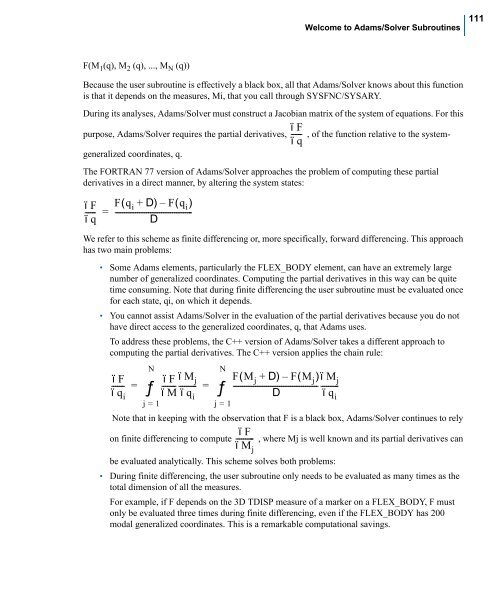Welcome to Adams/Solver Subroutines - Kxcad.net
Welcome to Adams/Solver Subroutines - Kxcad.net
Welcome to Adams/Solver Subroutines - Kxcad.net
You also want an ePaper? Increase the reach of your titles
YUMPU automatically turns print PDFs into web optimized ePapers that Google loves.
F(M 1 (q), M 2 (q), ..., M N (q))<br />
<strong>Welcome</strong> <strong>to</strong> <strong>Adams</strong>/<strong>Solver</strong> <strong>Subroutines</strong><br />
Because the user subroutine is effectively a black box, all that <strong>Adams</strong>/<strong>Solver</strong> knows about this function<br />
is that it depends on the measures, Mi, that you call through SYSFNC/SYSARY.<br />
During its analyses, <strong>Adams</strong>/<strong>Solver</strong> must construct a Jacobian matrix of the system of equations. For this<br />
purpose, <strong>Adams</strong>/<strong>Solver</strong> requires the partial derivatives, , of the function relative <strong>to</strong> the system-<br />
generalized coordinates, q.<br />
The FORTRAN 77 version of <strong>Adams</strong>/<strong>Solver</strong> approaches the problem of computing these partial<br />
derivatives in a direct manner, by altering the system states:<br />
∂ F<br />
-----<br />
∂ q<br />
F( qi + ∆)<br />
– F( qi) = -----------------------------------------<br />
∆<br />
We refer <strong>to</strong> this scheme as finite differencing or, more specifically, forward differencing. This approach<br />
has two main problems:<br />
• Some <strong>Adams</strong> elements, particularly the FLEX_BODY element, can have an extremely large<br />
number of generalized coordinates. Computing the partial derivatives in this way can be quite<br />
time consuming. Note that during finite differencing the user subroutine must be evaluated once<br />
for each state, qi, on which it depends.<br />
• You cannot assist <strong>Adams</strong>/<strong>Solver</strong> in the evaluation of the partial derivatives because you do not<br />
have direct access <strong>to</strong> the generalized coordinates, q, that <strong>Adams</strong> uses.<br />
To address these problems, the C++ version of <strong>Adams</strong>/<strong>Solver</strong> takes a different approach <strong>to</strong><br />
computing the partial derivatives. The C++ version applies the chain rule:<br />
∂ F<br />
-------<br />
∂ qi N<br />
∂ F<br />
-------<br />
∂ M<br />
∂ Mj = ∑ --------- =<br />
∂ qi j = 1<br />
N<br />
∑<br />
j = 1<br />
Note that in keeping with the observation that F is a black box, <strong>Adams</strong>/<strong>Solver</strong> continues <strong>to</strong> rely<br />
on finite differencing <strong>to</strong> compute , where Mj is well known and its partial derivatives can<br />
be evaluated analytically. This scheme solves both problems:<br />
• During finite differencing, the user subroutine only needs <strong>to</strong> be evaluated as many times as the<br />
<strong>to</strong>tal dimension of all the measures.<br />
For example, if F depends on the 3D TDISP measure of a marker on a FLEX_BODY, F must<br />
only be evaluated three times during finite differencing, even if the FLEX_BODY has 200<br />
modal generalized coordinates. This is a remarkable computational savings.<br />
∂ F<br />
-----<br />
∂ q<br />
F( Mj + ∆)<br />
– F( Mj) ----------------------------------------------<br />
∆<br />
∂ Mj ---------<br />
∂ qi ∂ F<br />
---------<br />
∂ Mj 111















